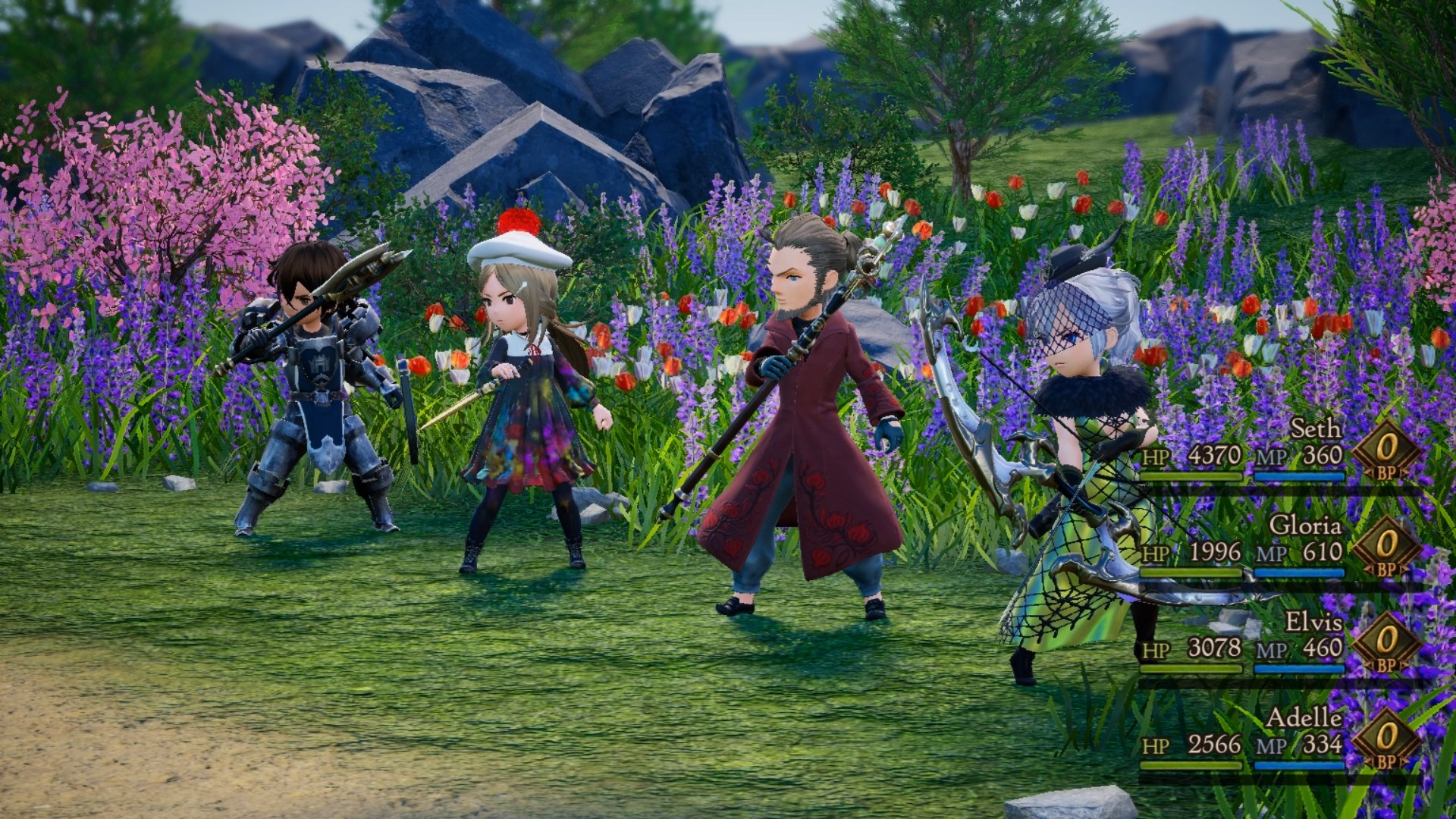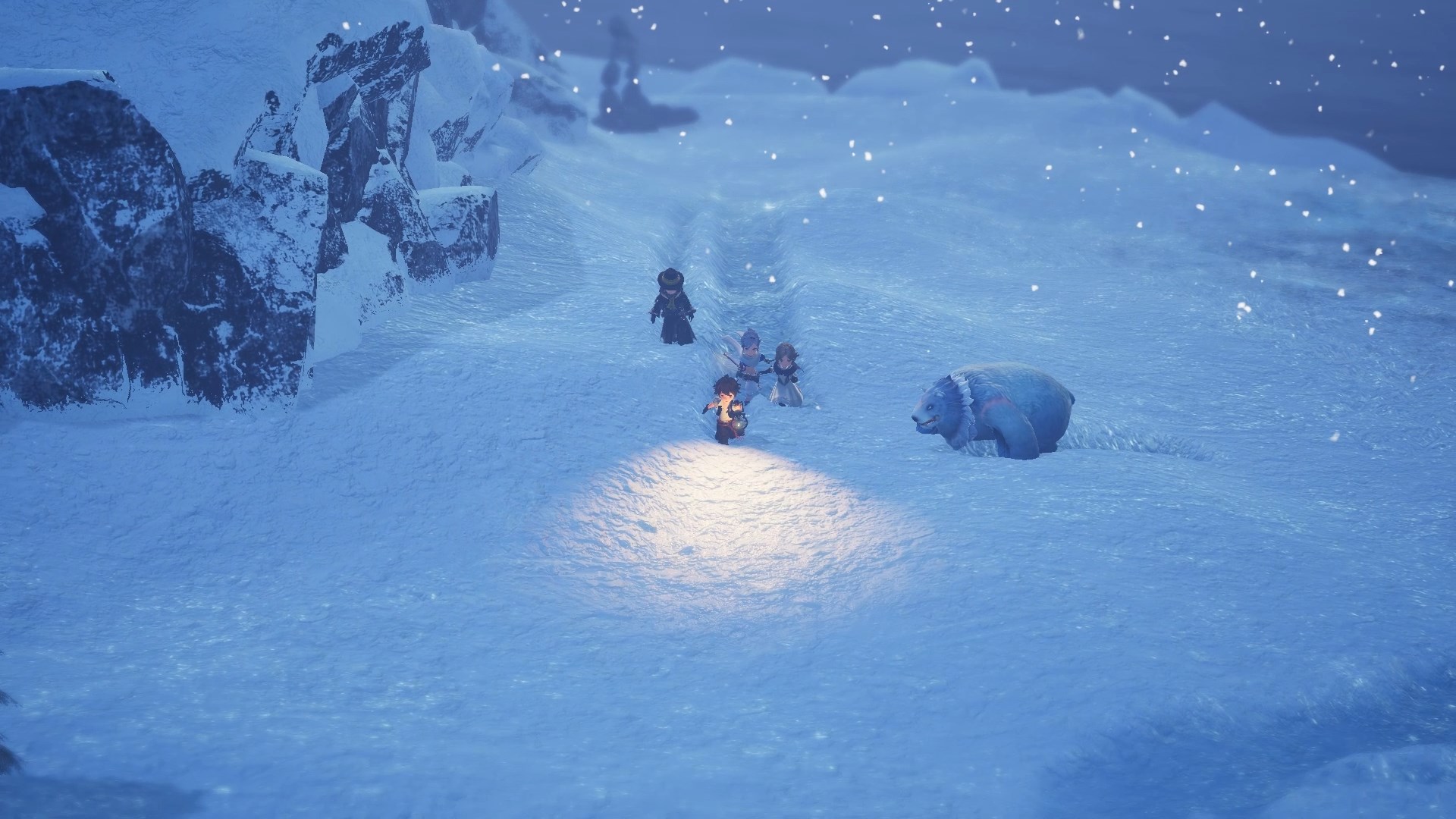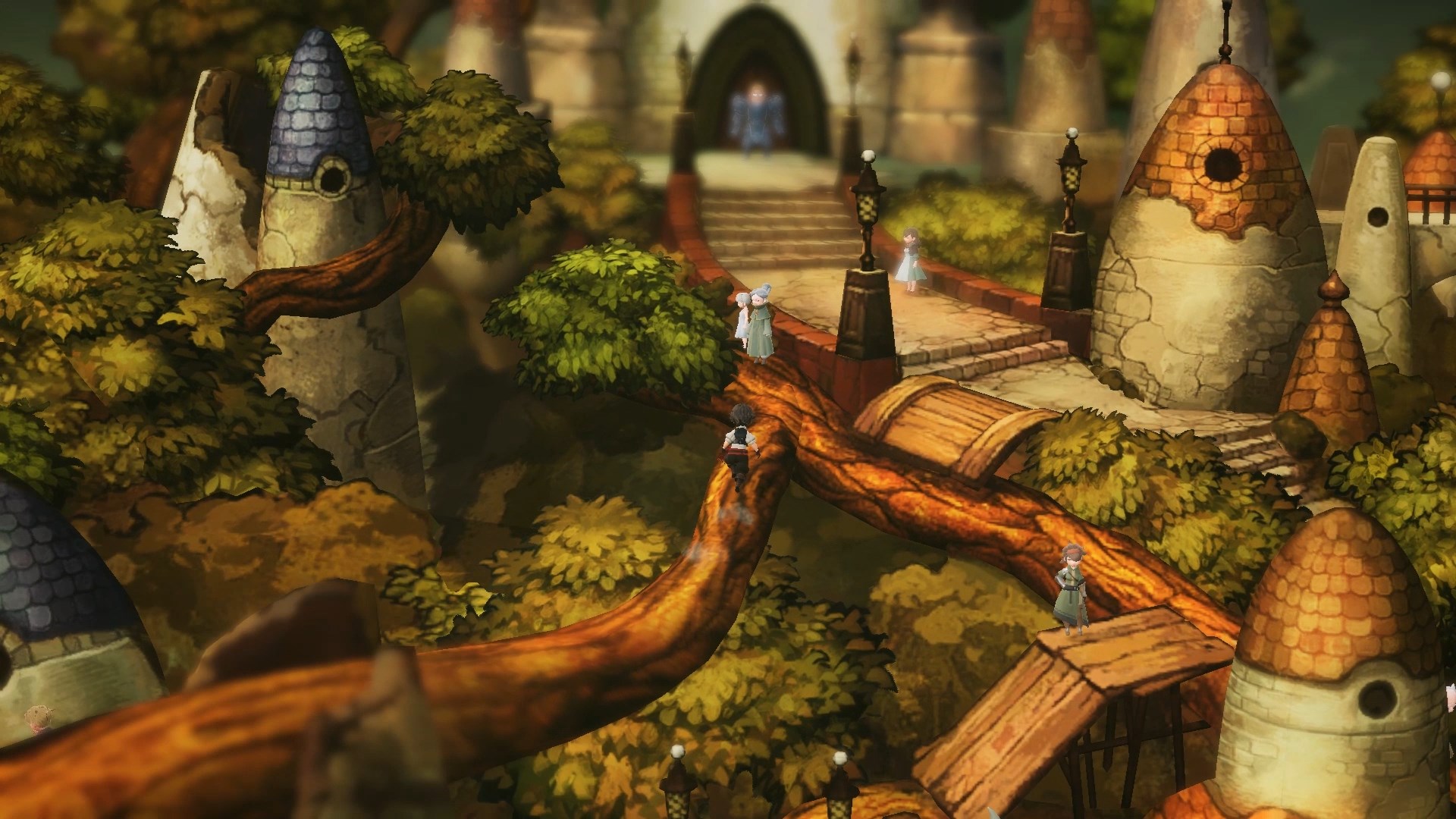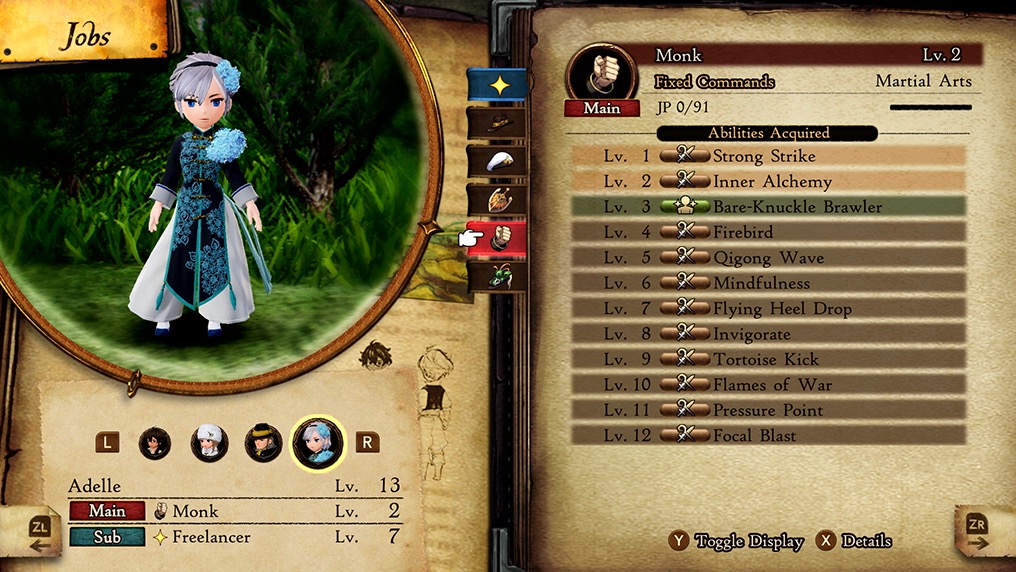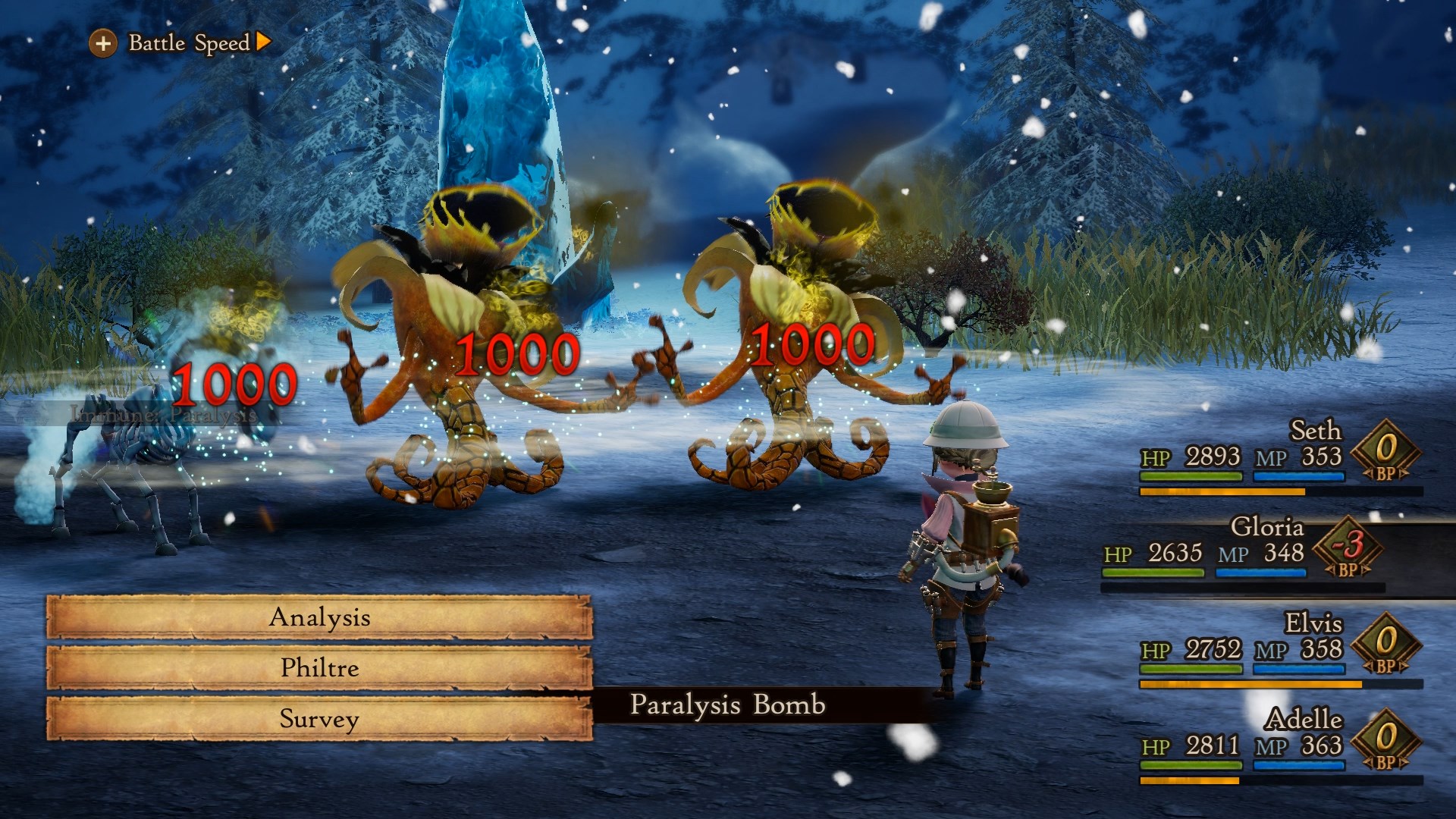Take this job and max it.
Bravely Default II is a prime example of a development team at the top of its game. The map exploration and turn-based combat are as tight and fluid as any JRPG I’ve played on the Nintendo Switch, and even further back than that. Unfortunately, a couple problems on the periphery prevent it from being as great as it could have been.
I first want to make it clear that knowledge of Bravely Default or Bravely Second: End Layer (both on the Nintendo 3DS) is not a requirement to enjoy this game. Although Bravely Default II is for some reason considered a direct sequel to Bravely Default, it has an all-new story with all-new characters…because Square Enix.
Also, if you played and didn’t enjoy the Bravely Default II demo, that doesn’t mean you won’t like the full game. Improvements have been made, yes. More importantly, however, the game just works better when you’re not dropped into the middle of the story and combat system. Plenty of the joy of Bravely Default II comes from building up your characters from scratch.
Those characters are Seth, Gloria, Elvis, and Adelle. Each of these four “Heroes of Light” has his/her own motivation for joining this adventure, but it eventually centers around the need to gather four crystals to prevent yet another apocalypse, of course. Damn crystals. You’d think we’d’ve learned by now.
Honestly, the story isn’t terribly compelling, and that’s one of the issues. The characters aren’t very interesting, either. They’re amiable, and their dialogue can be fun, but they’re not nearly as engaging as those we met in the previous two Bravely Default games. Even their names are lazy. Seth? Elvis? Adelle? I’ll take Ringabel, Agnes Oblige and Magnolia Arch, please.
Thankfully, most other elements of the game shine, starting with the overworld. Enemies can now be seen on the map, so random encounters aren’t an issue. You don’t know how many or exactly which types of monsters you’ll fight based on the enemy displayed on the screen, but you can at least make calculated decisions on when to avoid combat (you’re warned if the enemy is too tough, and they’ll flee if you’re over-powered). You can also now chop down grass, trees, etc. for money and items. Feeling the need to cut through everything slows down the exploration, but it’s satisfying when you stumble upon a large purse or a particularly useful item.
The UI includes a world map you can shrink/expand/hide, but it lacks the detail needed to be particularly useful. It’s also completely missing from the dungeons. In those, being able to track map progress was wonderful on the dual screens of the 3DS. I don’t like that you can’t see where you’ve been on the Switch, especially when you exit a dungeon only to find you left a treasure or two behind. That said, the diverse dungeon areas are mostly cleverly laid out and gorgeously rendered, so you may not mind revisiting them.
The towns in Bravely Default II also leave a bit to be desired. They looked fantastic in 3D, and although they retain their painterly visuals on the Switch, they’re not as impressive when laid flat. Also, they tend to look a bit blocky when the camera zooms in close on a specific area. Their cinematic presentation is wonderful when you’re zoomed out, but overall, Bravely Default II is a better fit visually for your Switch’s small screen. That makes sense, considering the game’s handheld origins.
The towns, of course, are where you stock up on items, pick up sidequests, heal up, and move the story along. Fast-travelling between them is handled via a wagon train, and you’re never too far from one. This is somewhat important, as you’ll need to revisit them in order to find and complete the sidequests. These aren’t required, but they’ll help you level up and learn more of the game’s lore.
Levelling up leads us directly into the job and combat systems, which are the big attraction to a Bravely Default game. Your four characters start out with equal stats, and you determine how they grow by defeating bosses to acquire “asterisks” that unlock jobs such as thief, ranger, berserker, and white mage. The more you use that job, the more skills you unlock, up to level 12. You can also assign a sub-job. Your sub-job doesn’t level up, but you can continue to use any of its skills you’ve already unlocked. Using the right job combos, then, is extremely important, and can really overpower your characters against some enemies. It’s also important to select weapons and armor that complement the abilities of your current job.
All of this is applied in turn-based battles that have been changed this time around. In previous Bravely Default games, you set up the actions for all four characters, watched them play out, then sat through the enemies’ turn. Now, turns are individual and speed-based. A meter shows how soon your characters will be able to act, while the enemies just get exclamation marks when their turn is approaching. This threw me off at first, but it’s a fair system. Gone are the times when I’d try to heal a character, only to have a retaliatory attack wipe her out first, causing the healing spell to become a waste of a turn and mana points.
Of course, the brave/default system from which the game gets its title remains. You can default to stock up your moves (BP) so you can brave to unleash up to four attacks in one turn. You can also choose to brave without first stocking up, but your character will be unable to move or defend until BP has returned to 0. It’s a wonderful system that’s easy to grasp and fun to apply to the multiple jobs and deep skill sets you’ll acquire.
Another new feature I really like is the use of support characters. From time to time, NPCs will join your party to help with battles. You can’t control them, but they’ll pop in to heal or attack as necessary. They don’t always make the best decisions, but they did save my hide on numerous occasions.
Also saving my hide is the new exploration system, which replaces the street pass connectivity of the 3DS games. Here, you simply send your characters on expeditions, then leave the game running when your Switch is asleep. When you return, you’ll discover a haul of numerous items, including precious JP for improving your job levels. Just remember to start an expedition before venturing into a dungeon, as you can only start the expeditions from within towns.
Unfortunately, not all of the new features are welcome. Bravely Default II includes a tactical card game you can play, for example, and I really hate that nonsense. I’m not sure why developers suddenly feel the need to jam unrelated mini-games into their RPGs, but I can forgive it if they’re easily ignored. Here, however, you must play it and play it well if you want to unlock all of the jobs, which you need for the true ending. Looks like I’ll be relying on YouTube to see that.
Still, complaints like this can be overlooked across this grand adventure. The numerous layers of Bravely Default II come together so cohesively that I continually wanted to jump back into it despite the perfunctory story. I still do, and now find myself hoping for Bravely Default II-2: End Layer Again…or whatever.
Review: Bravely Default II (Nintendo Switch)
Great
Despite a couple shortcomings with the story and extraneous elements, Bravely Default II is a rock-solid JRPG that will appeal to anyone with a love of world exploration, character management, and turn-based combat.


